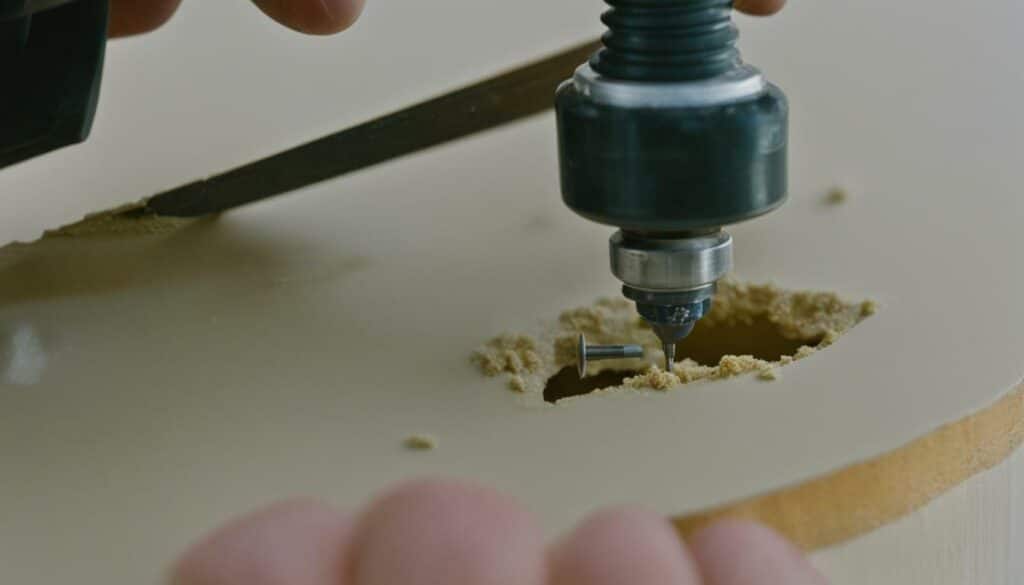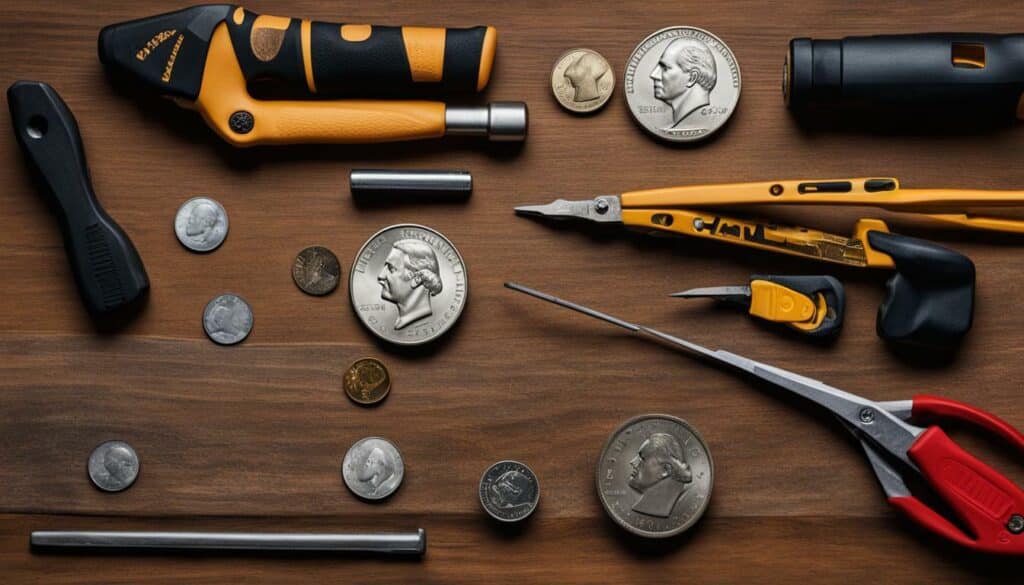
Welcome to our effortless guide on how to repair stripped screw holes in drywall. With our step-by-step instructions, you’ll be able to fix these common issues and restore your walls in no time.
Key Takeaways:
- To repair stripped screw holes in drywall, you can use toothpicks and wood glue, plastic wall plugs, or automotive filler.
- Using toothpicks and wood glue involves inserting toothpicks into the hole, applying wood glue, and letting it dry before reinserting the screw.
- Plastic wall plugs can be used by matching the size of the screw to the plugs and inserting them into the hole.
- For larger holes, automotive filler can be used by boring a new hole, filling it with the filler, and letting it dry before re-securing the screw.
- Ensure proper preparation of the wall and finishing the repaired area for a professional-looking result.
Understanding Stripped Screw Holes in Drywall
Before diving into the repair techniques, it’s important to understand why stripped screw holes happen in drywall and how to troubleshoot the problem. Stripped screw holes occur when the threads in the wall material become worn out or damaged, resulting in a loose grip on the screw. This can happen due to over-tightening, repeated use of the same screw hole, or poor quality drywall.
To troubleshoot the issue, start by examining the screw. If the screw threads appear worn or damaged, it’s best to replace it with a new one. If the screw is in good condition, the issue lies with the screw hole in the drywall.
Check if the hole is too large for the screw. If this is the case, using toothpicks and wood glue can help provide a tighter grip. If the hole is too small or damaged, plastic wall plugs are a suitable solution. For larger holes, automotive filler can be used to create a new secure anchor point for the screw.
By understanding the causes of stripped screw holes in drywall and troubleshooting the problem, you can effectively repair and reinforce the damaged areas. In the following sections, we will explore different repair methods in detail, providing you with step-by-step instructions and tips for a successful outcome. Whether you prefer an easy fix with toothpicks and wood glue or a more robust solution using plastic wall plugs or automotive filler, this guide has got you covered.
Repairing with Toothpicks and Wood Glue
One easy and effective method to repair stripped screw holes in drywall is using toothpicks and wood glue. Follow these steps to fix the issue with minimal effort:
- Start by inserting as many toothpicks as you can into the hole, making sure they fit snugly.
- Squeeze 2-3 drops of wood glue on the ends of the toothpicks and spread it with your finger or a cotton swab.
- Stick the toothpicks into the hole and snap off the excess.
- Let the glue dry for at least 1 hour.
- Re-insert the screw back into the hole.
With this method, the toothpicks and wood glue create a tight grip, allowing the screw to hold firmly in place once it’s reinstalled. It’s a simple and cost-effective solution that can save you time and money.
I had several stripped screw holes in my drywall, and I was worried about the cost and hassle of repairing them. But after discovering the toothpicks and wood glue method, I was amazed at how easy and effective it was. The toothpicks create a solid foundation, and the wood glue solidifies everything. Now my walls are as good as new!” – John D., DIY Enthusiast
Table: Comparison of Repair Methods
| Method | Effort Required | Cost | Effectiveness |
|---|---|---|---|
| Using Toothpicks and Wood Glue | Low | Inexpensive | High |
| Using Plastic Wall Plugs | Medium | Varies | Medium |
| Using Automotive Filler | High | Inexpensive | High |
Using Plastic Wall Plugs
If the toothpick and wood glue method doesn’t work for your stripped screw holes, using plastic wall plugs can be an effective alternative. Here’s how to do it yourself.
1. Start by selecting the appropriate plastic wall plugs. These plugs should match the size of your screw for a secure fit. If necessary, you may need to bore new holes using a drill bit that matches the diameter of the plugs.
2. Once you have the right plugs, insert them into the stripped screw holes. Make sure they fit snugly and are flush with the surface of the drywall. If the holes are larger than the plugs, you may need to apply a bit of pressure to insert them properly.
3. Once the plugs are in place, you can now re-insert the screw. Position the screw over the plug and gently apply pressure while turning it clockwise. The screw will grip the plug, creating a secure and stable connection.
4. Repeat the process for any additional stripped screw holes, ensuring that each plug is properly inserted before re-securing the screws.
Table: Plastic Wall Plug Sizes
| Screw Size | Plastic Wall Plug Size |
|---|---|
| #6 | 6mm |
| #8 | 8mm |
| #10 | 10mm |
| #12 | 12mm |
Using plastic wall plugs is a simple and effective way to repair stripped screw holes in drywall. It provides a reliable solution that allows you to securely reattach screws and maintain the integrity of your walls.
Remember to choose the correct size of plugs for your screws and ensure a proper fit. With a few basic tools and the right materials, you can easily fix stripped screw holes and restore the strength and stability of your drywall.
Repairing Larger Holes with Automotive Filler
For larger stripped screw holes in drywall, automotive filler can be a great solution. Follow these steps to quickly repair and reinforce the damaged area.
1. Bore a new hole: Use a drill bit slightly larger than the screw to create a new hole in the damaged area. This will provide a clean surface for the automotive filler to adhere to.
2. Mix the automotive filler: Prepare the automotive filler according to the manufacturer’s instructions. This usually involves mixing two components together until a smooth consistency is achieved.
3. Fill the hole: Apply the mixed automotive filler into the newly created hole, ensuring that it completely fills the space. Use a putty knife or a similar tool to smooth out the surface and remove any excess filler.
4. Secure the screw: While the filler is still wet, spray a lubricant onto the screw to prevent it from sticking. Insert the screw into the filled hole, making sure it is aligned properly. Let the filler dry for approximately 5 minutes before unscrewing the screw.
Additional Tips:
- If the filled hole is not level with the surrounding wall, you can sand the area lightly to achieve a smooth finish.
- Always follow the manufacturer’s instructions when using automotive filler, as drying times may vary.
- If you encounter any difficulties, consider seeking professional assistance to ensure a proper and long-lasting repair.
By following these steps and using automotive filler, you can quickly repair larger stripped screw holes in drywall and restore the integrity of your walls. Remember to take your time and ensure that the filler is dry before re-securing the screw. With a little patience and effort, your walls will look as good as new!
| Advantages of Using Automotive Filler for Larger Holes: |
|---|
| Provides a strong and durable repair |
| Allows for easy reinstallation of the screw |
| Can be sanded and painted to match the surrounding wall |
Preparing the Wall for Repair
Before you begin repairing the stripped screw holes, it’s important to properly prepare the wall to create a smooth and even finish. Here are some easy drywall repair techniques to help you get started:
- Clear the area: Remove any loose drywall particles or debris from the hole using a utility knife or sandpaper. This will ensure a clean surface for the repair.
- Apply primer: Use a paintbrush or roller to apply a coat of primer to the area surrounding the stripped screw holes. Primer helps the new drywall compound adhere better and promotes a seamless finish.
- Fill any gaps: If there are any gaps or cracks around the holes, fill them with a joint compound using a putty knife. Smooth out the compound and let it dry completely.
- Sand the surface: Once the joint compound is dry, lightly sand the area with fine-grit sandpaper to create a smooth surface. This will ensure that the repaired area blends seamlessly with the rest of the wall.
By following these drywall repair techniques, you can ensure that the surface is properly prepared for the next steps in fixing the stripped screw holes.
Quote: “Proper preparation is key to achieving a seamless repair when fixing stripped screw holes in drywall.” – DIY Home Improvement Magazine
Table: Tools and Materials for Wall Preparation
| Tools | Materials |
|---|---|
| Utility knife | Primer |
| Sandpaper (fine-grit) | Joint compound |
| Paintbrush or roller | Putty knife |
Repairing Small Holes with Spackle
Sometimes, when repairing stripped screw holes, you may encounter small holes that also need attention. Here’s how to easily fix them using spackle.
1. Start by cleaning the small hole, removing any loose debris or dust. Use a small brush or cloth to ensure a smooth surface.
2. Take a small amount of spackle on your putty knife and apply it to the hole. Use a pressing motion to fill the hole completely, ensuring it is slightly above the surface of the drywall.
3. Once the spackle has dried, usually within 30 minutes, use fine-grit sandpaper to gently sand down the excess spackle until it is level with the surrounding drywall surface.
4. To achieve a seamless finish, apply a second layer of spackle if necessary and repeat the sanding process after it has dried.
5. Once the surface is smooth and level, wipe away any dust with a clean cloth or sponge.
6. Your small hole is now ready for paint. Match the color of the surrounding area and apply a thin layer of paint to blend it in with the rest of the wall.
By following these easy steps, you can effectively repair small holes in drywall using spackle. Remember to take your time and ensure a smooth finish before painting for a seamless repair.
| Materials Needed: | Tools Needed: |
|---|---|
| – Spackle | – Putty knife |
| – Fine-grit sandpaper | – Small brush or cloth |
| – Clean cloth or sponge | – Paint (matching color) |
Sanding and Finishing the Repaired Area
Once you’ve completed the repairs, the next step is to sand and finish the area for a flawless finish that blends seamlessly with the rest of your wall. Sanding is an essential part of the process as it helps to smooth out any rough edges or uneven surfaces left behind after filling the screw holes. Use fine-grit sandpaper and gently sand the repaired area until it feels smooth to the touch.
After sanding, it’s time to apply the finish. This will not only enhance the appearance of the repaired area but also provide extra protection. Choose a paint or primer that matches the color of your wall and apply it evenly over the repaired section. Use a brush or roller for larger areas and a small brush for touch-ups.
Allow the finish to dry completely before evaluating the results. If necessary, apply a second coat for a more polished look. Once you’re satisfied with the finish, do a final check to ensure that the repaired area blends well with the rest of the wall. You should now have a seamless and professional-looking repair that is virtually undetectable.
Table: Recommended Tools and Materials
| Tools | Materials |
|---|---|
| Fine-grit sandpaper | Paint or primer |
| Brush or roller | |
| Small brush |
Remember, the key to a successful repair is patience and attention to detail. Take your time when sanding and applying the finish, ensuring that you achieve a smooth and seamless result. Don’t rush the process, as this can lead to subpar results. With the right tools, materials, and techniques, you can easily achieve a quick drywall hole repair and restore the beauty of your walls.
Continue reading to learn more essential tips and troubleshooting techniques in the next section.
Reinstalling the Screw
With the stripped screw holes repaired, it’s time to reinstall the screw properly to ensure a secure hold. Here’s what you need to know.
First, assess the size and type of screw that was originally used. Ensure you have a replacement screw that matches these specifications. Using a screw that is too long or too short may cause further damage to the repaired hole or result in a weak hold.
Before inserting the screw, apply a small amount of lubricant or wax to its threads. This will help the screw glide smoothly into the hole and reduce the risk of stripping the repaired area.
Align the screw with the repaired hole and slowly twist it clockwise to insert it into the drywall. Use a screwdriver or drill with a screwdriver attachment to turn the screw. Apply steady pressure, but avoid overtightening, as this can cause the drywall to crack or create new holes.
Once the screw is fully inserted, test its stability and ensure it feels secure. If necessary, tighten it slightly further to achieve the desired hold. Be cautious not to overtighten, as this can weaken the drywall or cause the screw to strip.
Reinstalling the screw is the final step in the repair process for stripped screw holes in drywall. Remember to choose a matching replacement screw, apply lubricant or wax to its threads, and gently twist it into the repaired hole. Check for stability and avoid overtightening. By following these steps, you can achieve a secure hold and restore the integrity of your drywall.
Additional Tips and Troubleshooting
To make your stripped screw hole repair experience even smoother, we’ve compiled some additional tips and troubleshooting advice to help you overcome any challenges you may encounter. Whether you’re dealing with stubborn holes or unexpected issues, these tips will guide you towards a successful repair.
Troubleshooting Stripped Screw Holes
If you’re having trouble identifying the cause of the stripped screw holes in your drywall, there are a few common culprits to consider. One possibility is that the screw was inserted at an angle, causing the hole to widen and lose its grip. In this case, you may need to drill a new hole slightly beside the original one and adjust the angle of insertion.
Another potential issue is using screws that are too long for the thickness of the drywall. To prevent this, always choose screws that are appropriate for the depth of your wall. If you’re unsure, consult a hardware store professional for guidance.
Additional Tips for a Seamless Repair
To ensure a seamless repair and prevent future stripped screw holes, keep these tips in mind:
- Apply a thin layer of wood glue around the perimeter of the hole before inserting the screw. This will provide extra adhesion and stability.
- For larger holes, consider reinforcing the repair with drywall tape or a patch kit before applying filler.
- Use a screwdriver with a good grip to avoid slipping and further damaging the screw hole.
- If you encounter resistance while reinserting the screw, remove it and double-check the hole for any lingering debris. Clean out any remaining wood or drywall particles before attempting again.
By following these troubleshooting tips and additional advice, you’ll be able to tackle stripped screw holes in drywall with confidence. Remember, patience and attention to detail are key to achieving a successful repair. Good luck!
Repairing Stripped Screw Holes in Drywall
To repair stripped screw holes in drywall, there are several methods you can try. One method is to use toothpicks and wood glue. Start by inserting as many toothpicks as you can into the hole, making sure they fit snugly. Then, squeeze 2-3 drops of wood glue on the ends of the toothpicks and spread it with your finger or a cotton swab. Stick the toothpicks into the hole and snap off the excess. Let the glue dry for at least 1 hour and then re-insert the screw back into the hole.
Another method is to use plastic wall plugs. Purchase wall plugs that match the size of your screw and insert them into the hole. If the plugs don’t fit, you may need to bore new holes with a drill.
Finally, you can use automotive filler for larger holes. Bore a new hole using a drill bit slightly larger than the screw, then mix the automotive filler according to the directions. Fill the hole with the filler and spray lubricant onto the screw. Insert the screw into the wet filler and let it dry for 5 minutes before unscrewing it. Let the filler dry overnight before re-securing the screw.
Conclusion
Congratulations! You now have the knowledge and confidence to repair stripped screw holes in drywall with ease. By following the step-by-step guide outlined in this article, you can revive your walls to their original glory and maintain the integrity of your home.
One effective method to repair stripped screw holes is to use toothpicks and wood glue. Simply insert toothpicks into the hole, apply wood glue, and let it dry before re-inserting the screw. This method provides a secure and long-lasting fix.
Another option is to use plastic wall plugs. These plugs can be purchased in various sizes to match the screws. They are easy to insert and provide a reliable solution for fixing stripped screw holes. In some cases, you may need to bore new holes with a drill to ensure a proper fit.
For larger holes, automotive filler can be a quick and effective solution. By boring a new hole and filling it with the filler, you can create a sturdy base for the screw. With the proper drying time, the repaired area will be ready for the screw to be securely re-attached.
With these methods and tips, you can confidently tackle any stripped screw holes in your drywall. Remember to properly prepare the wall, sand and finish the repaired area, and always troubleshoot any issues that may arise during the repair process. Good luck!
FAQ
How do I repair stripped screw holes in drywall?
There are several methods you can try. One method is to use toothpicks and wood glue. Another method is to use plastic wall plugs. For larger holes, you can use automotive filler. Follow the step-by-step instructions provided in this guide for each method.
Can I use toothpicks and wood glue to repair any size of stripped screw holes?
Toothpicks and wood glue are best suited for small to medium-sized holes. If the hole is too large, you may need to consider using plastic wall plugs or automotive filler.
What size of plastic wall plugs should I use?
The size of the plastic wall plugs should match the size of your screw. If the plugs don’t fit, you may need to bore new holes with a drill.
How long does it take for the wood glue to dry?
It is recommended to let the wood glue dry for at least 1 hour before re-inserting the screw into the hole.
How long should I let the automotive filler dry?
It is best to let the automotive filler dry overnight before re-securing the screw.
Can I use spackle to repair stripped screw holes?
Spackle is better suited for small holes rather than stripped screw holes. It is recommended to use toothpicks and wood glue, plastic wall plugs, or automotive filler for stripped screw holes.
What should I do if the repair doesn’t hold?
If the repair doesn’t hold, you may need to consider using a different method or seeking professional help. It is important to ensure the hole is properly filled and secured for a long-lasting repair.
Do I need any special tools for these repairs?
The tools needed will depend on the method you choose. Toothpicks, wood glue, plastic wall plugs, a drill, and automotive filler may be required. Make sure you have the necessary tools before starting the repair.
Can I reuse the same screw after repairing the hole?
In most cases, you should be able to reuse the same screw after repairing the hole. However, make sure the repaired area is secure and stable before reinserting the screw.
Are these methods suitable for all types of drywall?
These methods are generally suitable for most types of drywall. However, it is always recommended to test a small area first to ensure compatibility and assess the effectiveness of the repair.















